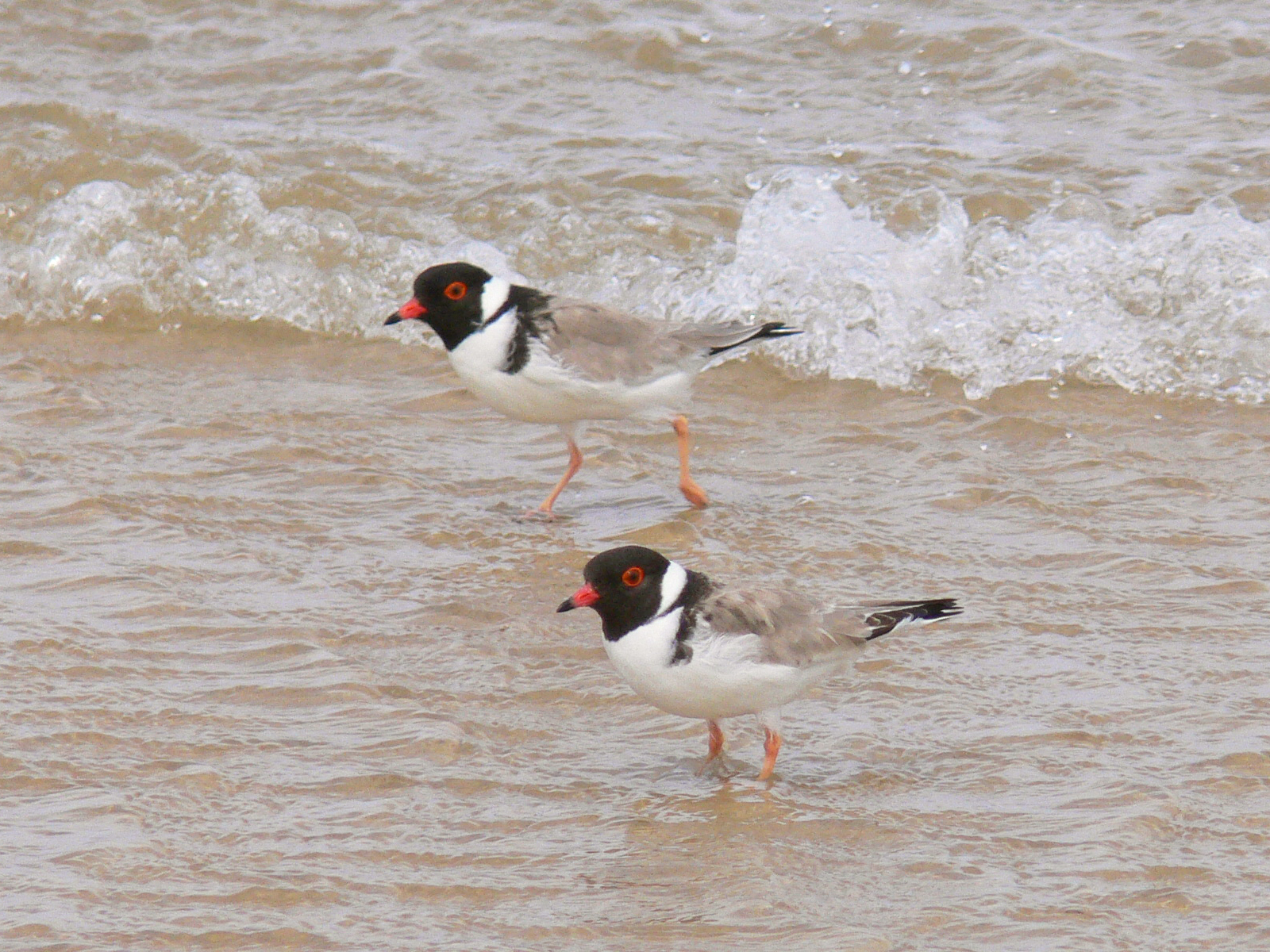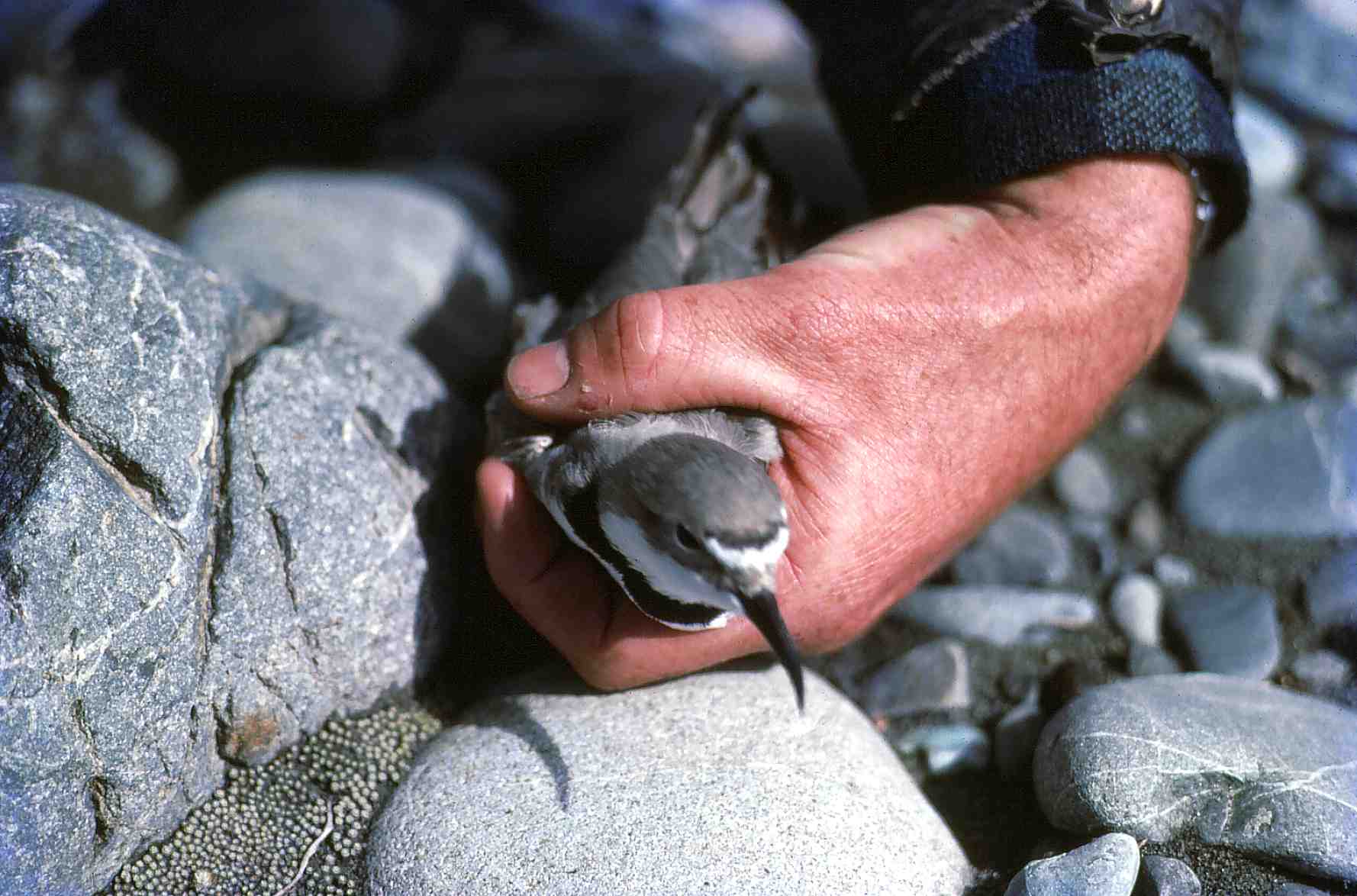|
Plover
Plovers ( , ) are a widely distributed group of wading birds belonging to the subfamily Charadriinae. Description There are about 66 species in the subfamily, most of them called "plover" or " dotterel". The closely related lapwing subfamily, Vanellinae, comprises about 20 species. Plovers are found throughout the world, with the exception of the Sahara and the polar regions, and are characterised by relatively short bills. They hunt by sight, rather than by feel as longer-billed waders like snipes do. They feed mainly on insects, worms or other invertebrates, depending on the habitat, which are obtained by a run-and-pause technique, rather than the steady probing of some other wader groups. Plovers engage in false brooding, a type of distraction display. Examples include pretending to change position or to sit on an imaginary nest site. Species list in taxonomic sequence The International Ornithological Committee (IOC) recognizes these 45 species of plovers and ... [...More Info...] [...Related Items...] OR: [Wikipedia] [Google] [Baidu] |
Charadrius
'' Charadrius '' is a genus of plovers, a group of wading birds. The genus name ''Charadrius'' is a Late Latin word for a yellowish bird mentioned in the fourth-century Vulgate. They are found throughout the world. Many ''Charadrius'' species are characterised by breast bands or collars. These can be (in the adult) complete bands (ringed, semipalmated, little ringed, long-billed), double or triple bands (killdeer, three-banded, Forbes', two-banded, double-banded) or partial collars (Kentish, piping, snowy, Malaysian, Javan, red-capped, puna). They have relatively short bills and feed mainly on insects, worms or other invertebrates, depending on habitat, which are obtained by a run-and-pause technique, rather than the steady probing of some other wader groups. They hunt by sight, rather than by feel as do longer-billed waders like snipe. Species of the genus ''Aegialites'' (or ''Aegialitis'') are now subsumed within ''Charadrius''. Taxonomy The genus ''Charadrius'' was introduc ... [...More Info...] [...Related Items...] OR: [Wikipedia] [Google] [Baidu] |
European Golden Plover
The European golden plover (''Pluvialis apricaria''), also known as the European golden-plover, Eurasian golden plover, or just the golden plover within Europe, is a largish plover. This species is similar to two other golden plovers: the American golden plover, ''Pluvialis dominica'', and Pacific golden plover, ''Pluvialis fulva'', which are both smaller, slimmer and relatively longer-legged than European golden plover, and both have grey rather than white axillary feathers (only properly visible in flight). Taxonomy The European golden plover was formally described by the Swedish naturalist Carl Linnaeus in 1758 in the tenth edition of his ''Systema Naturae''. He placed it with the other plovers in the genus ''Charadrius'' and coined the binomial name ''Charadrius apricarius''. The species is now placed in the genus '' Pluvialis'' that was introduced in 1760 by the French zoologist Mathurin Jacques Brisson. The genus name is Latin and means "relating to rain", from ''pluvia ... [...More Info...] [...Related Items...] OR: [Wikipedia] [Google] [Baidu] |
Little Ringed Plover (Charadrius Dubius) W IMG 0104
The little ringed plover (''Charadrius dubius'') is a small plover. The genus name ''Charadrius'' is a Late Latin word for a yellowish bird mentioned in the fourth-century Vulgate. It derives from Ancient Greek ''kharadrios'' a bird found in river valleys (''kharadra'', "ravine"). The specific ''dubius'' is Latin for doubtful, since Sonnerat, writing in 1776, thought this bird might be just a variant of common ringed plover. Description Adult little ringed plovers have a grey-brown back and wings, a white belly and a white breast with one black neckband. They have a brown cap, a white forehead, a black mask around the eyes with white above and a short dark bill. The legs are flesh-coloured and the toes are all webbed. This species differs from the larger ringed plover in leg colour, the head pattern, and the presence of a clear yellow eye-ring. Gallery Little Ringedplover by Sreedev Puthur.jpg, Little Ringed Plover Little ringed plover3.jpg, Little ringed plover in Kannur, ... [...More Info...] [...Related Items...] OR: [Wikipedia] [Google] [Baidu] |
Phegornis
The diademed sandpiper-plover or diademed plover (''Phegornis mitchellii'') is a Near Threatened species of bird in subfamily Charadriinae of family Charadriidae. It is found in Argentina, Bolivia, Chile, and Peru.HBW and BirdLife International (2022) Handbook of the Birds of the World and BirdLife International digital checklist of the birds of the world. Version 6b. Available at: http://datazone.birdlife.org/userfiles/file/Species/Taxonomy/HBW-BirdLife_Checklist_v6b_Jul22.zip retrieved December 5, 2022 Taxonomy and systematics The diademed sandpiper-plover is the only member of its genus and has no subspecies. The species has at times been thought to belong to family Scolopacidae (the sandpipers) but genetic data place it firmly with other plovers in family Charadriidae. It appears to be most closely related to several Australian and New Zealand plovers of genera Elseyornis, Peltohyas, Anarhynchus, and Pedionomus.Remsen, J. V., Jr., J. I. Areta, E. Bonaccorso, S. Claramun ... [...More Info...] [...Related Items...] OR: [Wikipedia] [Google] [Baidu] |
Thinornis
''Thinornis'' is a genus of plovers, comprising two extant and threatened species. It is sometimes considered a synonym of ''Charadrius''. Taxonomy The genus ''Thinornis'' was introduced in 1844 by the English zoologist George Robert Gray to accommodate a single species, ''Thinornis rossii'' G.R. Gray which is now considered a junior synonym of ''Charadrius movaeseelandiae'' J.F. Gmelin, the shore plover. The genus name combines the Ancient Greek ''this'' meaning "beach" or "sand" with ''ornis'' meaning "bird". The genus contains two species: *Hooded dotterel or hooded plover (''Thinornis cucullatus'') *Shore plover The shore plover ( mi, tūturuatu, Moriori: ''tchūriwat’'', ''Thinornis novaeseelandiae''), also known as the shore dotterel, is a small plover endemic to New Zealand. Once found all around the New Zealand coast, it is now restricted to a ... or shore dotterel (''Thinornis novaeseelandiae'') A third species, the Auckland Islands shore plover (''Thinornis ... [...More Info...] [...Related Items...] OR: [Wikipedia] [Google] [Baidu] |
Lapwing
Lapwings ( subfamily Vanellinae) are any of various ground-nesting birds (family Charadriidae) akin to plovers and dotterels. They range from in length, and are noted for their slow, irregular wingbeats in flight and a shrill, wailing cry. A group of lapwings is called a "deceit". The traditional terms "plover", "lapwing", and "dotterel" do not correspond exactly to current taxonomic models; thus, several of the Vanellinae are often called plovers, and one a dotterel, while a few of the "true" plovers (subfamily Charadriinae) are known colloquially as lapwings. In general, a lapwing can be thought of as a larger plover. In Europe's Anglophone countries, ''lapwing'' refers specifically to the northern lapwing, the only member of this group to occur in most of the continent and thus the first bird to go by the English name ''lapwing'' (also known as ''peewit'' or ''pyewipe''). Systematics While authorities generally agree that there about 25 species of Vanellinae, classific ... [...More Info...] [...Related Items...] OR: [Wikipedia] [Google] [Baidu] |
Hooded Dotterel
The hooded dotterel or hooded plover (''Thinornis cucullatus'') is a species of bird in the family Charadriidae. It is endemic to southern Australia, where it inhabits ocean beaches and subcoastal lagoons. There are two recognised subspecies which form isolated eastern and western populations. The eastern subspecies is of greater conservation concern, with listings varying from Vulnerable in South Australia and Victoria (Australia), Victoria to Critically Endangered in New South Wales. Taxonomy The hooded dotterel was placed in genus ''Charadrius'' but in the early 2000s it was reclassified into the genus ''Thinornis'', along with shore plover (''Thinornis novaeseelandiae''). In 2000 the number of mature individuals was estimated at 7,000. Alternative common names include: hooded plover, hoody, ''pluvier à camail'' (in French), ''kappenregenpfeifer'' (in German), and ''chorlito encapuchado'' (in Spanish). Subspecies Two subspecies of the hooded dotterel are now recognised. * ' ... [...More Info...] [...Related Items...] OR: [Wikipedia] [Google] [Baidu] |
Pluvialis
'' Pluvialis '' is a genus of plovers, a group of wading birds comprising four species that breed in the temperate or Arctic Northern Hemisphere. In breeding plumage, they all have largely black underparts, and golden or silvery upperparts. They have relatively short bills and feed mainly on insects, worms or other invertebrates, depending on habitat, which are obtained by a run-and-pause technique, rather than the steady probing of some other wader groups. They hunt by sight, rather than by feel as do longer-billed waders. Taxonomy The genus ''Pluvialis'' was introduced by the French zoologist Mathurin Jacques Brisson in 1760 with the European golden plover (''Pluvialis apricaria'') as the type species. The genus name is Latin and means relating to rain, from ''pluvia'', "rain". It was believed that they flocked when rain was imminent. The genus contains four species: The American and Pacific golden plovers were formerly considered conspecific Biological specificity is th ... [...More Info...] [...Related Items...] OR: [Wikipedia] [Google] [Baidu] |
Distraction Display
Distraction displays, also known as diversionary displays, or paratrepsis are anti-predator behaviors used to attract the attention of an enemy away from something, typically the nest or young, that is being protected by a parent. Distraction displays are sometimes classified more generically under "nest protection behaviors" along with aggressive displays such as mobbing. These displays have been studied most extensively in bird species, but also have been documented in populations of stickleback fishRuxton, Graeme D; Thomas N. Sherratt; Michael Patrick Speed. (2004) Avoiding attack: the evolutionary ecology of crypsis, warning signals and mimicry. Oxford University Press. . p. 198 and in some mammal species. Distraction displays frequently take the form of injury-feigning. However, animals may also imitate the behavior of a small rodent or alternative prey item for the predator; imitate young or nesting behaviors such as brooding (to cause confusion as to the true location of the ... [...More Info...] [...Related Items...] OR: [Wikipedia] [Google] [Baidu] |
Inland Dotterel
The inland dotterel (''Peltohyas australis'') is an endemic bird of the arid Australian interior. It forms loose flocks in sparsely vegetated gibber plain and claypans in the day where it loafs in the shade and eats shoots of shrubs. It is most often encountered at night when it forages on roads for insects. The relative remoteness of its habitat means that it is not well studied. The most detailed observations of the species were made by the South African arid-zone ornithology specialist Gordon Maclean in the 1970s. Alternate English names include Australian plover, inland plover, desert plover and prairie plover. Description The inland dotterel is a medium-sized plover with a distinctive cryptic plumage. Males and females are similarly sized: in length, a wingspan of a weight of , and a short bill . It is unlikely to be confused with any other species when found in its normal habitat. Its upperparts are a rich sandy buff, mottled with dark brown. The black band across the c ... [...More Info...] [...Related Items...] OR: [Wikipedia] [Google] [Baidu] |
Anarhynchus
The wrybill or (in Māori) ngutuparore (''Anarhynchus frontalis'') is a species of plover endemic to New Zealand. It is the only species of bird in the world with a beak that is bent sideways in one direction, always to the right (in the crossbills, e.g. '' Loxia pytyopsittacus'', the tips of the upper and lower mandibles cross because they are bent sideways in opposite directions, sometimes left over right and sometimes right over left). A 2015 study found it to be within the ''Charadrius'' clade, with other New Zealand plovers its closest relatives; the nearest being the New Zealand dotterel or New Zealand plover (''Charadrius obscurus''), and then the double-banded plover or banded dotterel (''Charadrius bicinctus''). It lays its eggs among the rocks along rivers and distracts intruders by pretending to be in distress and moving away from its clutch. It is rated as vulnerable on the International Union for Conservation of Nature (IUCN)'s Red List of Threatened Species. Taxono ... [...More Info...] [...Related Items...] OR: [Wikipedia] [Google] [Baidu] |
_W_IMG_0104.jpg)
_-_Ystad-2020.jpg)



